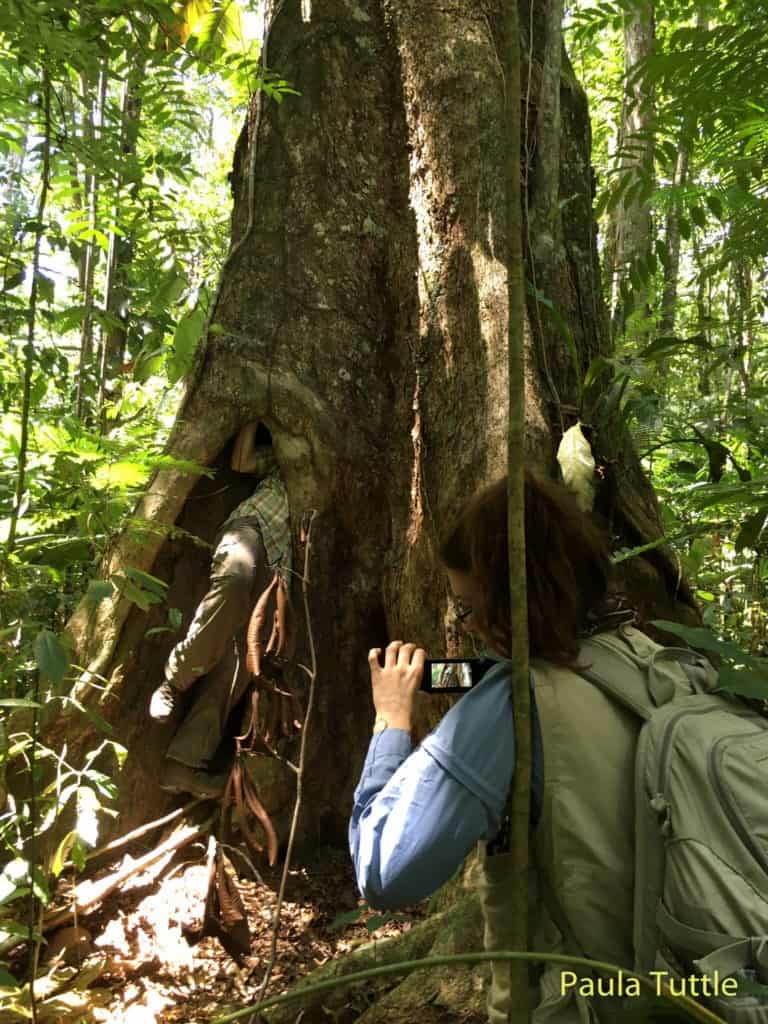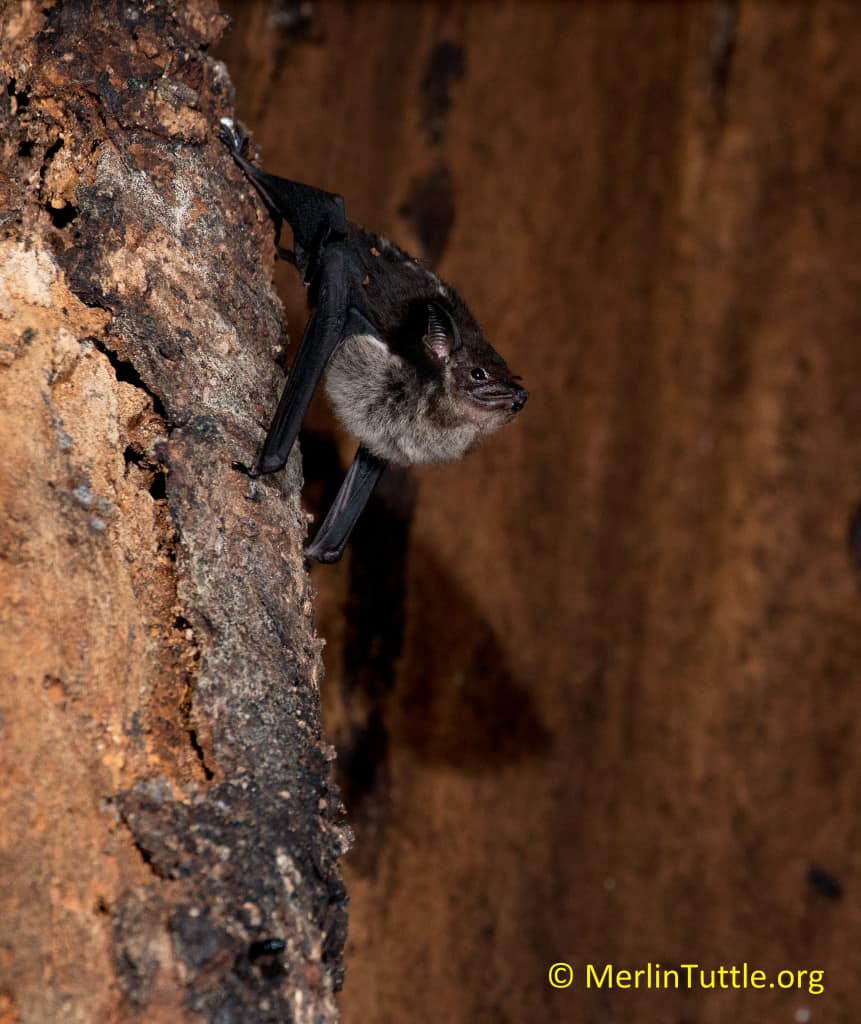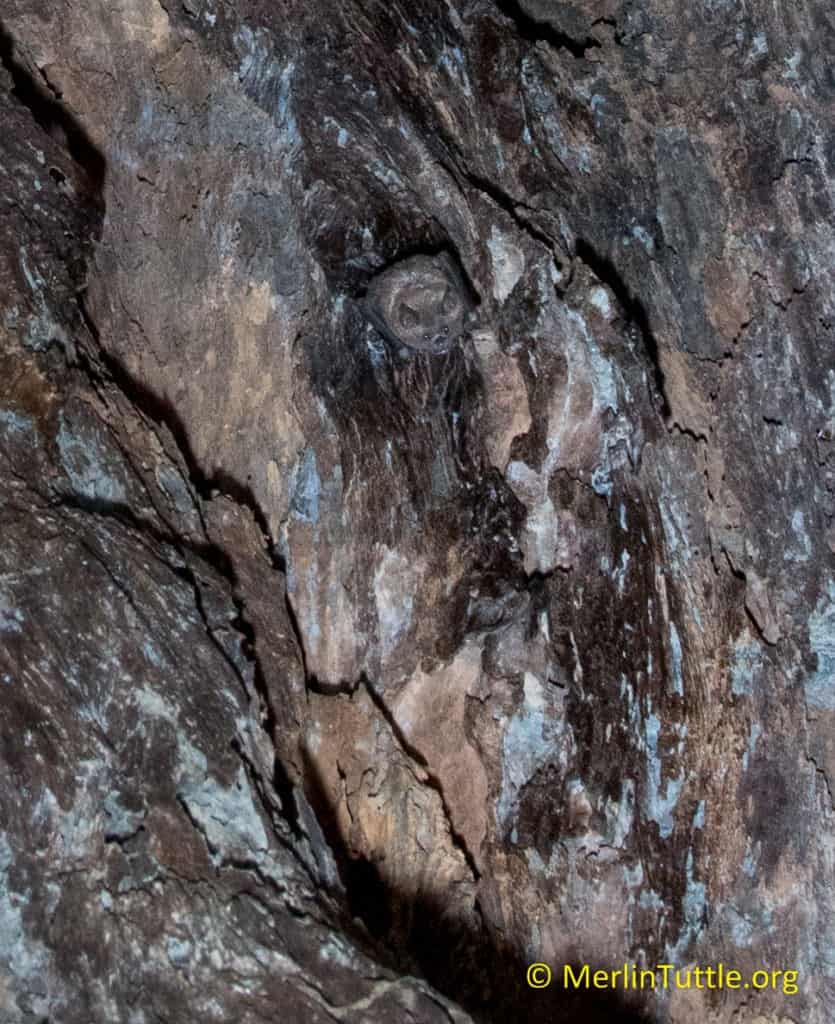Have you ever squeezed into a hollow tree in the rain forest? Me neither. But MTBC’s digital/social media coordinator, Teresa Nichta, followed Merlin into just such a tree during our recent field work in Trinidad searching for… hey, let’s hear the story from Teresa and make sure you watch the video at the end!
“Great, you’re finally here! Come on, we’re going hunting for katydids,” Merlin says. It’s nearly 11pm and I drop my bags, strap on my headlight and spray bug repellent on the brand new boots I’d been wearing since I boarded the plane in Texas for Trinidad.
So begins my first field experience with Merlin as I follow him into the darkness, “There’s one. Grab it before it gets away! We need all we can get. Our bat is hungry.” An hour later, I finally got to meet my first bat, a Little big-eared bat (Micronycteris megalotis), captured in the nearby rain forest a couple nights earlier. She was adorable! Merlin handed me a mealworm, said “Hold it up like this and call her,” and to my amazement she flew right over and eagerly plucked it directly from my fingers.
The next morning I got to see my first bats in the wild, but it wasn’t easy!
Our hosts, Geoffrey Gomes and Daniel Hargreaves, had warned us to watch carefully for well camouflaged but deadly fer-de-lance snakes. They’d already spotted several. As we entered the lush rain forest, I was enthralled by the huge Philodendron plants, hanging liana vines, gorgeous blue morpho butterflies and much more. For me it was a paradise of wonder, despite having to watch for all those snakes.
I’d been working with Merlin for several months by now but this was entirely new. When in the rain forest, he’s clearly in his element and I was trying to soak up every bit of wisdom I could. As Merlin went barging ahead, focused only on finding bat roosts and sharing facts, I wondered again if we shouldn’t be watching more carefully for snakes. He assured me, “I’ve rarely encountered them,” but admitted having once stepped on a fer-de-lance, lucky for him on its head!
When we finally found our first hollow tree, I held my breath as I filmed Merlin popping his head into a tiny hole and reported bats but no obvious snakes. Not seeing any was good enough for him and he immediately began his fearless attempt to wriggle inside. After several tight-squeeze tries he finally made it.
As the trip videographer, responsible for filming rain forest bats and the research required to understand and conserve them, I was quite happy with my footage of his entry (CHECK OUT THE VIDEO AT THE BOTTOM OF THIS BLOG!). Then Merlin called out, “This is a great opportunity to photograph bats. Come on in.” Putting thought of deadly snakes and strange bugs aside, I followed Batman into an incredible experience few have witnessed. Fearlessness paid off!
The bats seemed relatively unafraid. Short-tailed fruit bats (Carollia perspicillata), the area’s most abundant seed-dispersing species, and Common long-tongued bats (Glossophaga soricina) clustered together just a few feet above us. Higher up we could see male Greater white-lined bats (Saccopteryx bilineata), insect-eaters, hovering and singing in front of prospective mates. The sac-winged bats were jet black with pairs of white stripes on their backs, and some of the long-tongued bats were bright yellow, apparently still covered in pollen from visits to Kapok tree flowers the night before.
Brilliant, emerald-colored beetle wings, dropped by feeding bats, littered the floor on top of a small pile of bat droppings. Guano provided food for a whole ecosystem of organisms, ranging from invisible bacteria to giant cave cockroaches (Blaberus giganteus), some three inches long. The roaches skittering all around us made me cringe. They were, none the less, admittedly beautiful and I knew they were harmless. I couldn’t help but appreciate them as just a few of the many unique critters that depend on energy from bats.
Merlin explained how bat guano is a rich source of energy for countless organisms, some of which may have great value in solving human waste problems, such as detoxifying ammonia from industry or converting seafood wastes into gasohol. I use bat guano in my garden at home and seeing the benefits there it isn’t hard to imagine the impact on a larger scale.
Our next blog will continue with more of Teresa’s adventures with Merlin.



